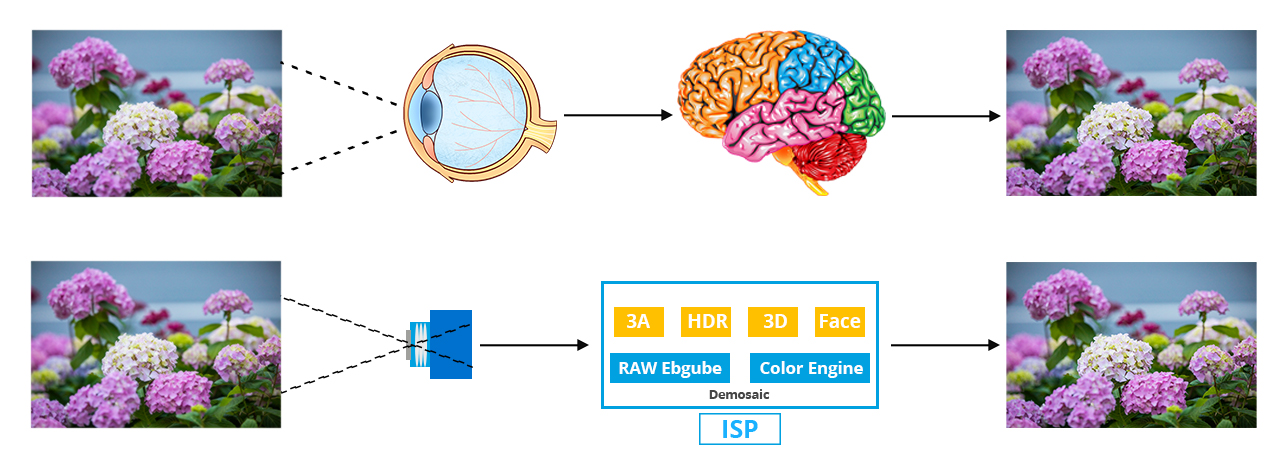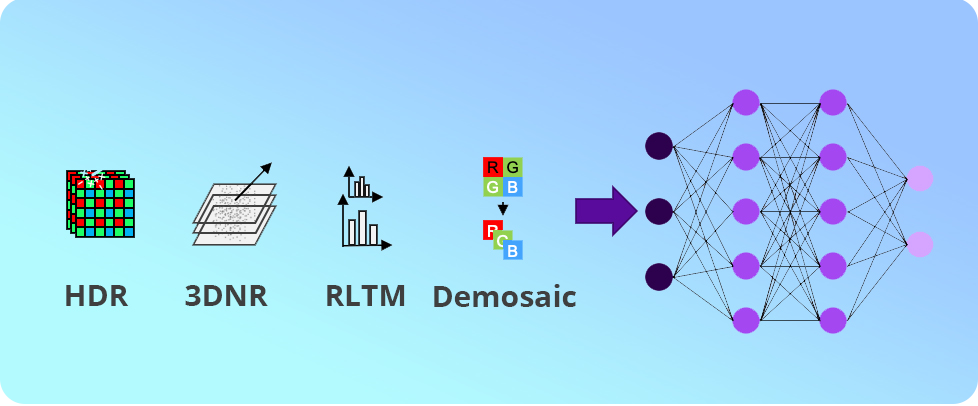From the early days of smartphones with a few million pixels to today's DSLR cameras and smartphones with tens of millions or even over a hundred million pixels, the relentless pursuit of perfect image quality has driven the iterative advancements in imaging devices. After all, in the face of our own eyes, with their astonishing 576 million pixels of resolution, everything still seems less real.
The development of cameras has always relied on the support of ISP (Image Signal Processor) technology. For traditional ISP technology, capturing night scenes and high dynamic range (HDR) scenes has been particularly challenging. Issues like noise, motion blur, overexposure, and loss of low-light information in dynamic night scenes not only fail to meet the increasing demand for image recording but also hinder the progress of industries like video surveillance and traffic management.
Yet, technology continues to break barriers, always surpassing our imaginations. While people are still critical of the flaws in traditional ISP, the rapid progress of AI offers us more possibilities. The emergence of AI-ISP technology makes high-definition full-color imaging in extremely low-light conditions possible. Cameras are transitioning from "seeing" to "seeing clearly" and even "understanding" the scenes they capture.
The era of "True Black-light" is officially upon us.
"True Blacklight," empowering the intelligent IoT
Let's talk about "True Blacklight." Based on different night vision effects, cameras can be distinguished by various names such as low-light, starlight, super starlight, and blacklight. These terms don't have a unified standard, but the focus is on whether the camera can maintain full-color imaging under low-light conditions. Generally, "blacklight level" means that the camera can operate at 0.01lux or below.
Traditionally, achieving blacklight effects involved using large-format sensors, low-resolution sensors with larger pixel sizes, increasing aperture size, or reducing video frame rates to capture more light and color information at night. However, these methods often resulted in less than 100% color saturation, motion artifacts, and increased costs due to larger sensors and apertures, which couldn't fully meet industry demands.
In other words, "you can't have your cake and eat it too" in extremely dark environments.
Nevertheless, there is a solution with AI-ISP technology that brings true blacklight full-color imaging to reality. Cameras equipped with AI-ISP can achieve real-time color restoration at less than 0.01Lux without the need for white light or infrared illumination. The color saturation remains at or above 100%, and moving objects appear without significant trailing, ghosting, or perspective issues. According to experts, only by meeting the following six key elements can it be called "True Blacklight" and truly help users achieve better video performance in extremely dark scenarios.

Thanks to the breakthrough of "True Blacklight," smart cities and intelligent IoT have expanded their application scenarios. In extremely dark environments like intersections, mountains, ponds, and farmlands, video brightness can be enhanced without sacrificing image quality, enabling cameras to capture well-structured, accurately color-restored color videos. Additionally, this technology achieves full-scene video effects, providing more precise intelligent analysis in places like ponds and farmlands where supplementary lighting is not feasible.
AI-empowered key modules, edge-optimized - maximizing AI-ISP performance
ISP stands for Image Signal Processor, responsible for converting signals from image sensors into recognizable information for humans and machines. It plays a crucial role in image quality. In a human analogy, ISP functions like the brain of the imaging system, processing, enhancing, and improving the collected images from the lens sensor to deliver a true or even better imaging quality.

Traditional ISP takes the raw data output from CIS sensors and converts it into human-readable YUV data following a specific pipeline sequence. Image processing in traditional ISP relies on mathematical modeling and human's naive understanding of images. In contrast, AI-ISP, a recent technological concept, builds upon the traditional ISP pipeline but overcomes its limitations using AI neural networks. By simulating the human brain with richer parameters and establishing more complex models, AI-ISP surpasses the ceiling of traditional ISP, achieving superior image quality.
Currently, AI-ISP empowers the four critical modules in the ISP pipeline—HDR, 3DNR, RLTM, and Demosaic—by continuously enhancing their performance through AI training. This breakthrough in AI-ISP shatters the limitations of traditional ISP imaging.

The reason for choosing to AI-empower the key modules is that the edge-side computing power is often limited. Considering practical deployment with concerns about power consumption and costs, applying AI processing to the entire pipeline is not feasible. AI-ISP, in essence, is closer to true productization, as it focuses AI on the most critical and visually discernible functionalities, making the best use of the limited computing power for optimal AI-ISP performance.
Therefore, in practical applications, AI-ISP can enhance performance by iterating visual models, facilitating rapid chip product upgrades in terms of image quality. This means a single chip can cover different scenarios and markets, reducing overall AI application costs and significantly enhancing productivity.
Currently, we are not only continuing to optimize and iterate the AI algorithms related to HDR, 3DNR, RLTM, and Demosaic, but also exploring the AI-empowerment of other modules in the traditional ISP pipeline. In addition, to meet the high computing power requirements of AI-ISP, we have also independently developed a mixed-precision NPU, further accelerating the efficiency of AI development and implementation.
Regarding the relationship between AI-ISP and "True Black Light," experts point out that in the era of 0.01 lux black light, simply improving lenses and sensors cannot address the fundamental issues. Traditional ISPs are unable to meet the technological advancement demands for black light, leading to various misleading approaches such as frame rate reduction and increased supplementary lighting. They believe that a qualified true black light full-color camera should ensure real-time (25-30) fps performance without the need for supplementary lighting in 0.01 lux scenarios, accurately distinguish moving objects, and faithfully reproduce colors. This is precisely the distinctive advantage of AI-ISP.
In fact, it was in 2020 that AI-ISP officially entered the market, leading to the rapid development of the new category of "True Black Light Full-Color Cameras."
As we can see, with the increasing demand for higher imaging quality in extreme scenarios such as low-light, high dynamics, and light pollution, AI-ISP is becoming increasingly crucial in the field of artificial intelligence visual imaging. By innovatively addressing the industry's core pain points related to low light and high dynamics, AI-ISP has created new product categories like the True Black Light Full-Color Camera, unlocking new visual possibilities for people. In the future, it may even lead us into a new era of imaging.